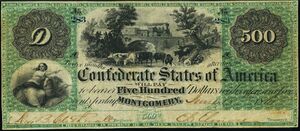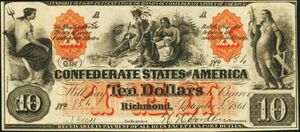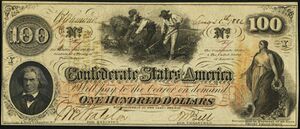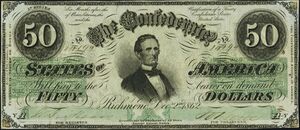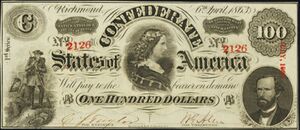An Overview of Confederate Currency Series and Types
This article provides a overview of the seven Confederate currency Series authorized by Acts of the Confederate Congress between 1861 and 1864. These seven Series consisted of 70 different design/denomination Types.
First Series (Act of March 9, 1861) (Type 1-6)
The Act of March 9, 1861 authorized the issue of $1 million of high denomination interest-bearing Treasury notes at an annual rate of 3.65%. The first four types of notes were issued at Montgomery, Alabama, and were not intended for general circulation. The Act was amended on August 3, 1861, to allow another $1 million of notes to be issued to replace the retiring Montgomery notes. These $100 and $50 notes (popularly known as Richmond notes) also bore interest at the annual rate of 3.65% and were not typically used for general commerce.
- Montgomery Issue:
- T-1 $1000 various written dates (607 issued) (National Bank Note Company)
- T-2 $500 various written dates (607 issued) (National Bank Note Company)
- T-3 $100 various written dates (1,606 issued) (National Bank Note Company)
- T-4 $50 various written dates (1,606 issued) (National Bank Note Company)
- Richmond Issue:
- T-5 $100 various written dates (5,798 issued) (Southern Bank Note Company)
- T-6 $50 various written dates (5,798 issued) (Southern Bank Note Company)
Second Series (Act of May 16, 1861) (Type 7-12)
By May 1861, the Confederacy was in desperate need of additional currency to keep its economy going. The Act of May 16, 1861 authorized $20 million of Treasury notes to be issued in denominations from $5 to $100. These notes did not pay interest. Instead, the terms on the notes were "Payable two years after the date of a treaty of peace between the Confederate States and the United States".
- All of the Second Series notes were dated July 25th, 1861.
- T-7 $100 Ceres and Proserpine (37,155 issued) (Hoyer & Ludwig)
- T-8 $50 George Washington (123,564 issued) (Hoyer & Ludwig)
- T-9 $20 Saling Ship (264,988 issued) (Hoyer & Ludwig)
- T-10 $10 Liberty and Eagle (170,994 issued) (Hoyer & Ludwig)
- T-11 $5 Liberty and Eagle (73,355 issued) (Hoyer & Ludwig)
- T-12 $5 Manouvrier (15,556 issued) (Jules Manouvrier)
Third Series (Act of August 19, 1861) (Type 13-37,46)
The Act of August 19, 1861 authorized $100 million of new paper money in denominations between $5 and $100. This was succeeded by the Act of December 24, 1861, which authorized another $50 million to be printed. These notes were fundable in 8% stock or bonds and were payable six months after the ratification of a peace treaty between the CSA and the United States.
- All of the Third Series notes were dated September 2, 1861.
- T-13 $100 Slaves loading cotton (629,284 issued) (Hoyer & Ludwig)
- T-14 $50 Moneta and treasure chests (469,660 issued) (Hoyer & Ludwig)
- T-15 $50 Locomotive and train (14,860 issued) (Southern Bank Note Company)
- T-16 $50 Jefferson Davis (425,944 issued) (Keatinge & Ball)
- T-17 $20 Ceres between Commerce and Navigation (43,732 issued) (Hoyer & Ludwig)
- T-18 $20 Sailing Ship (2,366,486 issued) (Hoyer & Ludwig)
- T-19 $20 Navigation by a globe (14,860 issued) (Southern Bank Note Company)
- T-20 $20 Industry (2,834,251 issued) (B. Duncan)
- T-21 $20 Alexander H. Stephens (164,248 issued) (Keatinge & Ball)
- T-22 $10 Family of Indians (58,860 issued) (Southern Bank Note Company)
- T-23 $10 Wagon load of cotton (20,333 issued) (Leggett, Keatinge & Ball)
- T-24 $10 R.M.T. Hunter (278,400 issued) (Leggett, Keatinge & Ball)
- T-25 $10 R.M.T. Hunter and C.G. Memminger (178,716 issued) (Keatinge & Ball)
- T-26 $10 R.M.T. Hunter and C.G. Memminger (Red X X) (514,400 issued) (Keatinge & Ball)
- T-27 $10 Liberty and Eagle (8,576 issued) (Hoyer & Ludwig)
- T-28 $10 Ceres and Commerce (1,074,980 issued) (Hoyer & Ludwig)
- T-29 $10 Slave picking cotton (286,627 issued) (B. Duncan)
- T-30 $10 General Marion's Sweet Potato Dinner (1,939,810 issued) (B. Duncan)
- T-31 $5 Commerce, Agriculture, Justice, Liberty and Industry (58,860 issued) (Southern Bank Note Company)
- T-32 $5 Blacksmith with anvil (20,333 issued) (Leggett, Keatinge & Ball)
- T-33 $5 C.G. Memminger (136,736 issued) (Leggett, Keatinge & Ball)
- T-34 $5 C.G. Memminger (228,644 issued) (Keatinge & Ball)
- T-35 $5 Indian Princess (7,160 issued) (Hoyer & Ludwig)
- T-36 $5 Commerce and cotton (3,694,890 issued) (J.T. Paterson)
- T-37 $5 Sailor with bales of cotton (1,002,478 issued) (B. Duncan)
- T-46 $10 Commerce and cotton (635,250 issued) (Hoyer & Ludwig). These notes were dated September 2nd, 1862 in error, and are actually Third Series notes, although they are often listed in Type numerical order, and included in the Fourth Series.
- Note: The T-38 $2 notes dated September 2nd, 1861 are actually an error on the part of the printer. They should have been dated June 2nd, 1862 and are actually Fourth Series notes.
Fourth Series (Act of April 17, 1862) (Type 38-45)
The Act of April 17, 1862 authorized $170 million in new paper money in denominations of $1 and $2, as well as $100 interest-bearing notes which paid a 7.3% annual interest rate. This April Act was followed up by the Act of September 23, 1862, which authorized another $5 million in $1 and $2 notes. These notes were payable six months after the ratification of a peace treaty between the CSA and the United States.
- All of the Fourth Series $1 and $2 notes were dated June 2nd, 1862 (except for T-38 notes which were erroneously dated September 2nd, 1861).
- T-38 $2 South striking down the Union (approximately 36,000 notes issued) (B. Duncan). These notes were erroneously dated September 2nd, 1861 by the printer. They should have been dated June 2nd, 1862 and are actually Fourth Series notes.
- T-39 $100 dated May 5th, 1862 - August 15, 1862, and September 12th, 1862. Locomotive (straight steam) and train (284,000 issued) (Hoyer & Ludwig, J.T. Paterson & Company)
- T-40 $100 dated August 9th, 1862 - January 16th, 1863. Locomotive (diffused steam) and train (214,400 issued) (J.T. Paterson & Company)
- T-41 $100 dated August 26th, 1862 - January 8th, 1863. Slaves hoeing a field (670,400 issued) (Keatinge & Ball)
- T-42 $2 South striking down the Union (1,520,000 issued) (B. Duncan)
- T-43 $2 South striking down the Union (Green Two underprint) (194,900 issued) (B. Duncan)
- T-44 $1 Steamship at sea (1,689,860 issued) (B. Duncan)
- T-45 $1 Steamship at sea (Green One underprint) (412,500 issued) (B. Duncan)
- Note: The T-46 $10 notes were dated September 2, 1862 in error, and are actually Third Series notes, although they are often listed in Type numerical order, and included here in the Fourth Series.
- Note: Types 47 and 48 are fantasy issues of unknown origin during the War.
Fifth Series (Act of October 13, 1862) (Type 49-55)
The Act of October 13, 1862 authorized $90 million of paper money in denominations of $1 to $100 and paid no interest. (More than $138 million was actually issued). The Fifth Series represented the first standardized designs of the Confederacy and were payable six months after the ratification of a peace treaty between the CSA and the United States.
- The Fifth Series notes were all dated December 2, 1862.
- T-49 $100 Lucy Pickens (628,640 issued) (Keatinge & Ball)
- T-50 $50 Jefferson Davis (414,200 issued) (Keatinge & Ball)
- T-51 $20 State Capitol in Nashville (776,800 issued) (Keatinge & Ball)
- T-52 $10 Proposed State Capital in Columbia, SC (3,060,000 issued) (Keatinge & Ball)
- T-53 $5 State Capitol in Richmond (2,833,600 issued) (Keatinge & Ball)
- T-54 $2 Judah P. Benjamin (607,000 issued) (Keatinge & Ball)
- T-55 $1 Clement C. Clay (1,141,200 issued) (Keatinge & Ball)
Sixth Series (Act of March 23, 1863) (Type 56-63)
The Act of March 23, 1863 authorized $50 million per month of paper money bearing no interest, in denominations from $5 to $100. In addition, another $15 million was authorized in small denominations of $0.50, $1 and $2 for the entire issue. A total of over $517.9 million of notes were issued. The Sixth Series followed the standard Fifth Series designs. The $0.50, $1 and $2 were payable six months after ratification of a treaty of peace between the CSA and United States, and the higher denomination $5 thru $100 notes were payable two years after the ratification of a treaty of peace. The $5 thru $100 notes were also stamped with the month of issue, as they could be funded into 6% bonds within 12 months of issue.
- The Sixth Series notes were all dated April 6, 1863.
- T-56 $100 Lucy Pickens (1,950,400 issued (Keatinge & Ball)
- T-57 $50 Jefferson Davis (2,349,600 issued (Keatinge & Ball)
- T-58 $20 State Capitol in Nashville (4,429,600 issued (Keatinge & Ball)
- T-59 $10 Proposed State Capital in Columbia, SC (7,420,800 issued (Keatinge & Ball)
- T-60 $5 State Capitol in Richmond (7,745,600 issued (Keatinge & Ball)
- T-61 $2 Judah P. Benjamin (689,200 issued (Keatinge & Ball)
- T-62 $1 Clement C. Clay (1,645,600 issued (Keatinge & Ball)
- T-63 $0.50 Jefferson Davis (1,831,517 issued (Keatinge & Ball)
Seventh Series (Act of February 17, 1864) (Type 64-72)
The Act of February 17, 1864 authorized $200 million of paper money bearing no interest, in denominations from $0.50 to $500. (More than $400 million was actually issued). The Seventh Series followed the standard Fifth & Sixth Series designs with the exception of the T-68 $10 which has a new central vignette and the new T-64 $500 design. All of the Seventh Series notes were payable two years after the ratification of a treaty of peace.
- All of the Seventh Series notes were dated February 17, 1864.
- T-64 $500 Stonewall Jackson (approximately 154,000 issued) (Keatinge & Ball)
- T-65 $100 Lucy Pickens (approximately 964,000 issued) (Keatinge & Ball)
- T-66 $50 Jefferson Davis (1,671,444 issued) (Keatinge & Ball)
- T-67 $20 State Capitol in Nashville (approximately 4,150,000 issued) (Keatinge & Ball)
- T-68 $10 Horses pulling cannon (approximately 9,071,000 issued) (Keatinge & Ball)
- T-69 $5 State Capitol in Richmond (approximately 5,526,100 issued) (Keatinge & Ball)
- T-70 $2 Judah P. Benjamin (approximately 944,000 issued) (Keatinge & Ball)
- T-71 $1 Clement C. Clay (approximately 681,500 issued) (Keatinge & Ball)
- T-72 $0.50 Jefferson Davis (approximately 1,100,000 issued) (Keatinge & Ball)
Sources
- Collecting Confederate Paper Money (Field Edition 2014) by Pierre Fricke, 2014.
